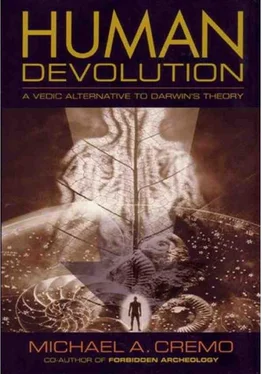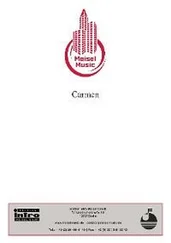Michael Cremo - Human Devolution - A Vedic Alternative To Darwin's Theory
Здесь есть возможность читать онлайн «Michael Cremo - Human Devolution - A Vedic Alternative To Darwin's Theory» весь текст электронной книги совершенно бесплатно (целиком полную версию без сокращений). В некоторых случаях можно слушать аудио, скачать через торрент в формате fb2 и присутствует краткое содержание. Год выпуска: 2003, ISBN: 2003, Издательство: Torchlight Publishing, Жанр: Старинная литература, на английском языке. Описание произведения, (предисловие) а так же отзывы посетителей доступны на портале библиотеки ЛибКат.
- Название:Human Devolution: A Vedic Alternative To Darwin's Theory
- Автор:
- Издательство:Torchlight Publishing
- Жанр:
- Год:2003
- ISBN:9780892133345
- Рейтинг книги:4 / 5. Голосов: 1
-
Избранное:Добавить в избранное
- Отзывы:
-
Ваша оценка:
- 80
- 1
- 2
- 3
- 4
- 5
Human Devolution: A Vedic Alternative To Darwin's Theory: краткое содержание, описание и аннотация
Предлагаем к чтению аннотацию, описание, краткое содержание или предисловие (зависит от того, что написал сам автор книги «Human Devolution: A Vedic Alternative To Darwin's Theory»). Если вы не нашли необходимую информацию о книге — напишите в комментариях, мы постараемся отыскать её.
Human Devolution: A Vedic Alternative To Darwin's Theory — читать онлайн бесплатно полную книгу (весь текст) целиком
Ниже представлен текст книги, разбитый по страницам. Система сохранения места последней прочитанной страницы, позволяет с удобством читать онлайн бесплатно книгу «Human Devolution: A Vedic Alternative To Darwin's Theory», без необходимости каждый раз заново искать на чём Вы остановились. Поставьте закладку, и сможете в любой момент перейти на страницу, на которой закончили чтение.
Интервал:
Закладка:
The material energies are of two basic kinds: the subtle material energies and the gross material energies. Conscious selves existing in levels or regions of the cosmos dominated by the subtle material energies have bodies composed principally of the subtle material energies—mind ( manas ), intelligence ( buddhi ), and false ego ( ahankara ). Conscious selves existing in the realm dominated by the gross material energies have, in addition to a bodily covering made of the subtle material energies, a bodily covering made of the gross material energies—earth ( bhumi ), water ( apa ), fire ( anala ), air ( vayu ), and ether ( kham ).
God himself (Krishna) is not directly involved in the affairs of manifesting the material universes to accommodate the conscious selves who have departed from the spiritual level of reality. For this purpose Krishna expands himself as the Maha Vishnu, who lies in the Causal Ocean. From the pores of Maha Vishnu come numberless universes. By His glance, the Maha Vishnu injects conscious selves into each universe. The Maha Vishnu also expands into each universe as the Garbhodakashayi Vishnu. From the Garbhodakashayi Vishnu in each universe comes a subordinate creator god, Brahma. Brahma is one of the conscious selves injected into a universe. He is charged with populating the universe. He does this by manifesting bodies to serve as vehicles for conscious selves.
Brahma exists on the highest, most subtle level of the material universe. His place is called Brahmaloka. The body of Brahma is composed primarily of the subtle material elements. In his commentary on Chaitanya Charitamrita ( Adi lila 5.22), Bhaktivedanta Swami Prabhupada said, “The residents of Brahmaloka do not have gross material bodies to change at death, but they transform their subtle bodies into spiritual bodies and thus enter the spiritual sky.” From his mind, Brahma directly produces mental sons ( manasa putras ), such as the sage Kardama Muni. Then from his body, Brahma produces other sages and the first sexually reproducing pair—Svayambhuva Manu and his consort Shatarupa. The Sanskrit word svayambhuva means self born. Svayambhuva Manu and Shatarupa have sons and daughters. The daughters are given in marriage to some of the mental sons of Brahma, and they begin to produce children. This reproduction of great sages, demigods, and demigoddesses takes place on the higher more subtle levels of the material universe.
When it is time for the production of the forms for souls who require bodies made of the grosser material elements, the demigods and demigoddesses engage in reproductive activities to produce them. In the course of these reproductive activities they make use of bijas, or seeds. These bijas contain the plans for the forms of the bodies. Modern biologists have difficulty explaining exactly how the process of development takes place. Each plant or animal generally begins as a single cell, which begins to divide. Each cell contains the same DNA, the same set of genes. So it is not easy to explain how and why, in the course of the progressive division of a few cells into millions of cells (trillions in the case of humans), that the cells sequentially differentiate and arrange themselves into complex forms of bodily tissues. I propose that associated with each form is not only the DNA but also a bija , or subtle seed, containing the developmental plan for the particular kind of body.
In Bhagavad Gita (14.4) Krishna says, “I am the seed-giving father of all living entities.” And in Bhagavad Gita (7.10) Krishna says, “I am the original seed of all existences.” The word used for “seed” in this case is bija. It could be taken to mean the atma (conscious self), which comes from Krishna. Bodies are vehicles for conscious selves, and without the presence of a conscious self, a body would not exhibit symptoms of life. But the presence of the conscious self is not itself sufficient to explain the form of a particular body. All bodies, according to Vedic thought, have conscious selves, including plants and animals. But each unit of conscious selfhood resembles the others. If the conscious self is the same in all bodies, then how do we explain the generation of different kinds of bodies?
We can do so by considering an additional meaning of the word bija, or seed. In his commentary to Chaitanya Charitamrita ( madhya lila 19.152), Bhaktivedanta Swami Prabhupada said, “Everything has an original cause, or seed. For any idea, program, plan or device, there is first of all the contemplation of the plan, and that is called the bija, or seed.” I propose that the development of bodily forms involves a seed of this type, in addition to the seed of the soul. This subtle developmental seed contains the plan for the body. In his commentary on Shrimad Bhagavatam (3.10.7), Bhaktivedanta Swami Prabhupada explained that in the beginning “the living entities were all already generated in seedling forms by the Supreme Personality of Godhead, and Brahma was to disseminate the same seedlings all over the universe.” From this it can be taken that the seeds (or seedlings) were given to the demigods, demigoddesses, and sages, who then used them in their reproductive processes to produce the forms of bodies to serve as vehicles for conscious selves.
Bodies of living things are manifested in the course of cyclical creations and destructions of universes and the planets within them. The basic unit of Vedic cyclical time is called the day of Brahma. The day of Brahma lasts for 4,320,000,000 years and is followed by a night of Brahma, which also lasts for 4,320,000,000 years. During the nights of Brahma, the conscious selves enter the body of the Garbhodakashayi Visnu in each universe and remain there until the next day of Brahma begins. Each day of Brahma is divided into 14 manvantara periods, each lasting about 300,000,000 years. There is normally a partial devastation between each manvantara period. During this period, the planets of the higher demigods are not touched, but the earthly planetary system is devastated. After each manvantara period, the demigods must again manifest the bodily vehicles for conscious selves. We are now in the seventh manvantara period. This means there have been six devastations, after which the earth has again been repopulated. This is interesting, because according to modern paleontology, the history of life on earth has been interrupted by six major extinction events, spaced at intervals of about the same order of magnitude as the devastations between the manvantara periods.
The fourth chapter of the sixth canto of Shrimad Bhagavatam contains a description of how repopulation occurred at the beginning of the sixth manvantara period. The repopulation was carried out by Daksha, a prajapati (generator of population). Shrimad Bhagavatam (6.4.19–20) says, “With his mind, Prajapati Daksha first created all kinds of demigods, demons, human beings, birds, beasts, aquatics and so on. But when Prajapati Daksha saw that he was not properly generating all kinds of living entities, he approached a mountain near the Vindhya mountain range, and there he executed very difficult austerities.” After this, Daksha and his wife Asikni had sixty daughters. The daughters were given to various demigods and sages. The sage Kashyapa received seventeen daughters as wives. In Shrimad Bhagavatam (6.6.24–26), Shukadeva Goswami said to King Parikshit, “O King Parikshit, now please hear from me the names of Kashyapa’s wives, from whose wombs the population of the entire universe has come. They are the mothers of almost all the population of the entire universe, and their names are very auspicious to hear. They are Aditi, Diti, Danu, Kashtha, Arishta, Surasa, Ila, Muni, Krodhavasa, Tamra, Surabhi, Sarama and Timi.” Some of the wives of Kashyapa gave birth to various kinds of demigods. According to Shrimad Bhagavatam (6.6.26–31), others produced various species of animals: “From the womb of Timi all the aquatics took birth, and from the womb of Sarama the ferocious animals like the tigers and lions took birth. My dear King Parikshit, from the womb of Surabhi the buffalo, cow and other animals with cloven hooves took birth, from the womb of Tamra the eagles, vultures and other large birds of prey took birth. . . . The sons born of Krodhavasa were the serpents known as dandasuka, as well as other serpents and the mosquitoes. All the various creepers and trees were born from the womb of Ila. . . . animals whose hooves are not split, such as the horse, were born from the womb of Kashtha.” One of the wives of Kashyapa was Aditi, and one of her sons was Aryama. Shrimad Bhagavatam (6.6.42) states: “From the womb of Matrka, the wife of Aryama, were born many learned scholars. Among them Lord Brahma created the human species, which are endowed with an aptitude for self-examination.” Exactly how the demigods use their reproductive processes to generate the bodily forms for conscious selves is not specified in the Shrimad Bhagavatam. But from other parts of the Vedic literature, we get some clues. The mahabharata ( Adi Parva 118) tells us that once the sage Kindama and his wife transformed themselves into deer to engage in sexual intercourse. Not understanding their identities, King Pandu killed them, and was cursed. Similarly, we learn in the seventeenth chapter of the Ramayana of Valmiki that various demigods took on the forms of monkeys and engaged in reproductive activities to generate a population of monkeys with humanlike intelligence. Therefore, it is possible that the demigods take on the forms of a particular species and then, using bijas supplied by God, engage in a special kind of sexual reproduction in order to produce bodies of that same kind, as vehicles for conscious selves. Once this happens, reproduction of that species can continue in the ordinary way. There are, however, instances where demigods and humans on this planet produce offspring. For example, Arjuna, the hero of the Bhagavad Gita was born of a terrestrial mother, Kunti, and a celestial father, the demigod Indra.
Читать дальшеИнтервал:
Закладка:
Похожие книги на «Human Devolution: A Vedic Alternative To Darwin's Theory»
Представляем Вашему вниманию похожие книги на «Human Devolution: A Vedic Alternative To Darwin's Theory» списком для выбора. Мы отобрали схожую по названию и смыслу литературу в надежде предоставить читателям больше вариантов отыскать новые, интересные, ещё непрочитанные произведения.
Обсуждение, отзывы о книге «Human Devolution: A Vedic Alternative To Darwin's Theory» и просто собственные мнения читателей. Оставьте ваши комментарии, напишите, что Вы думаете о произведении, его смысле или главных героях. Укажите что конкретно понравилось, а что нет, и почему Вы так считаете.












